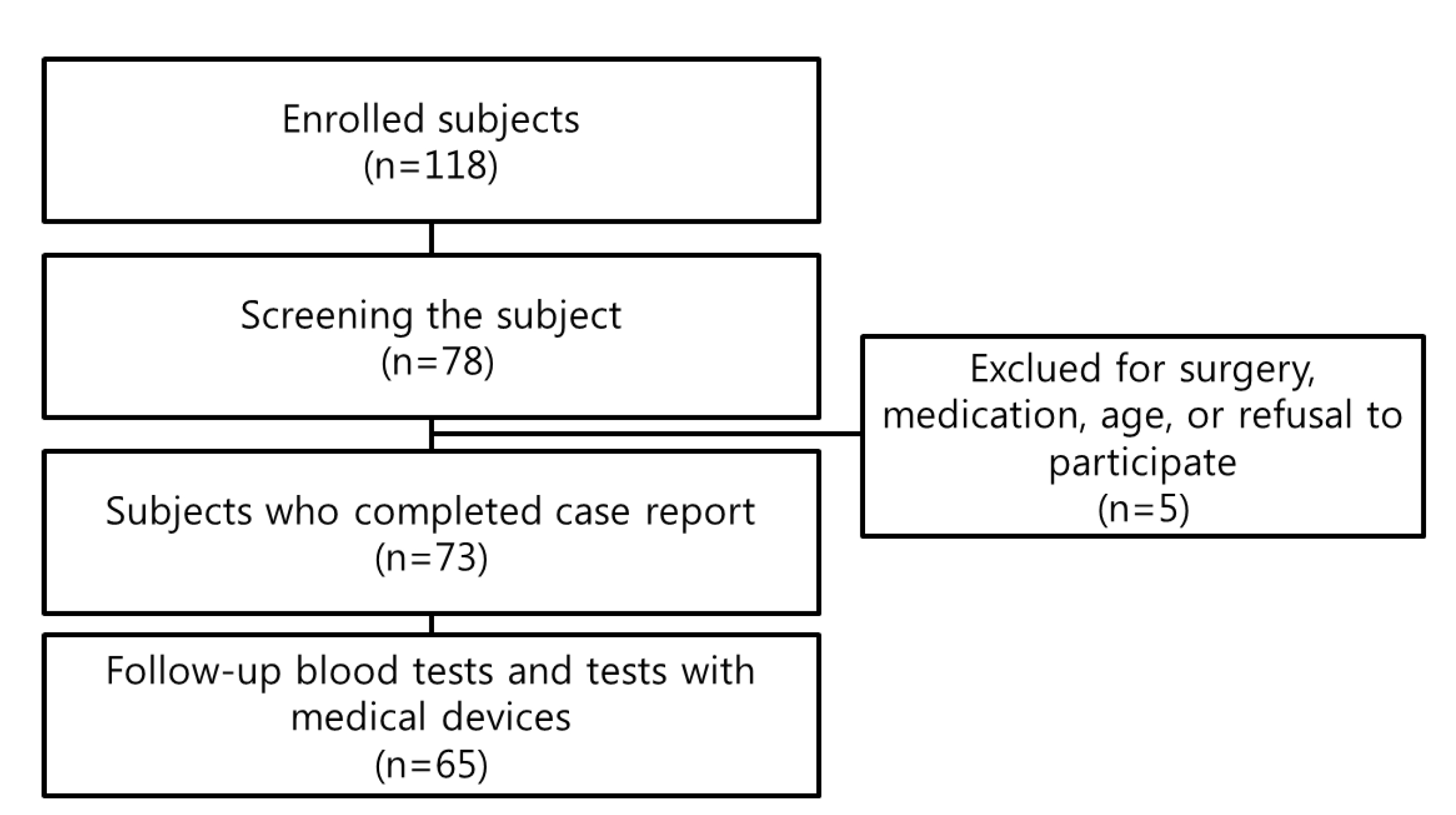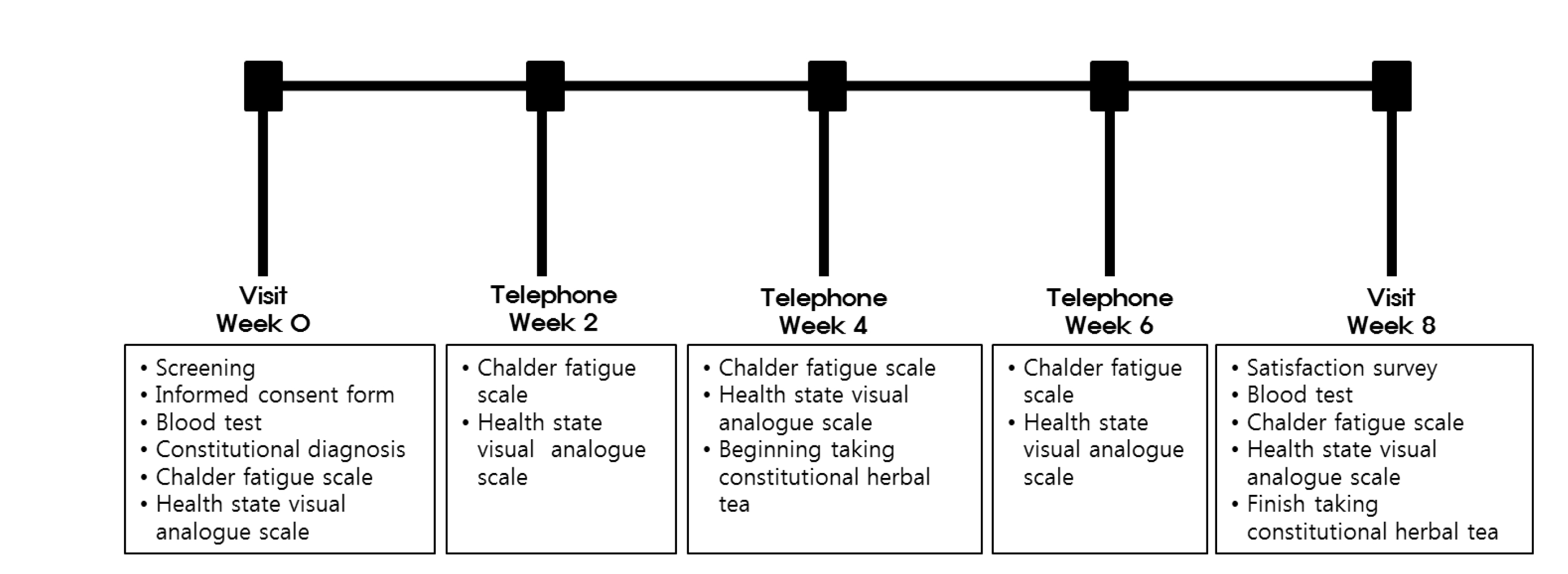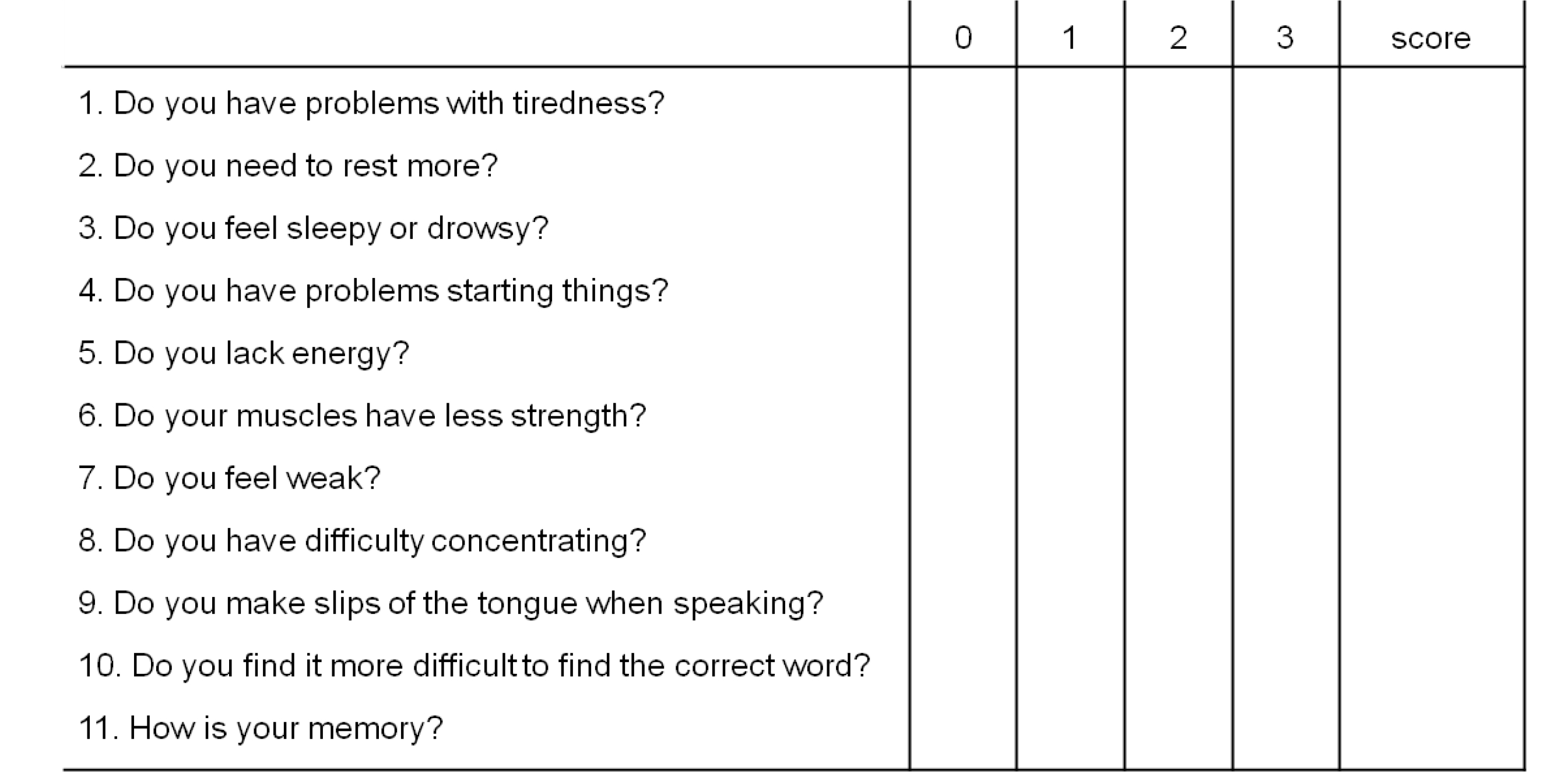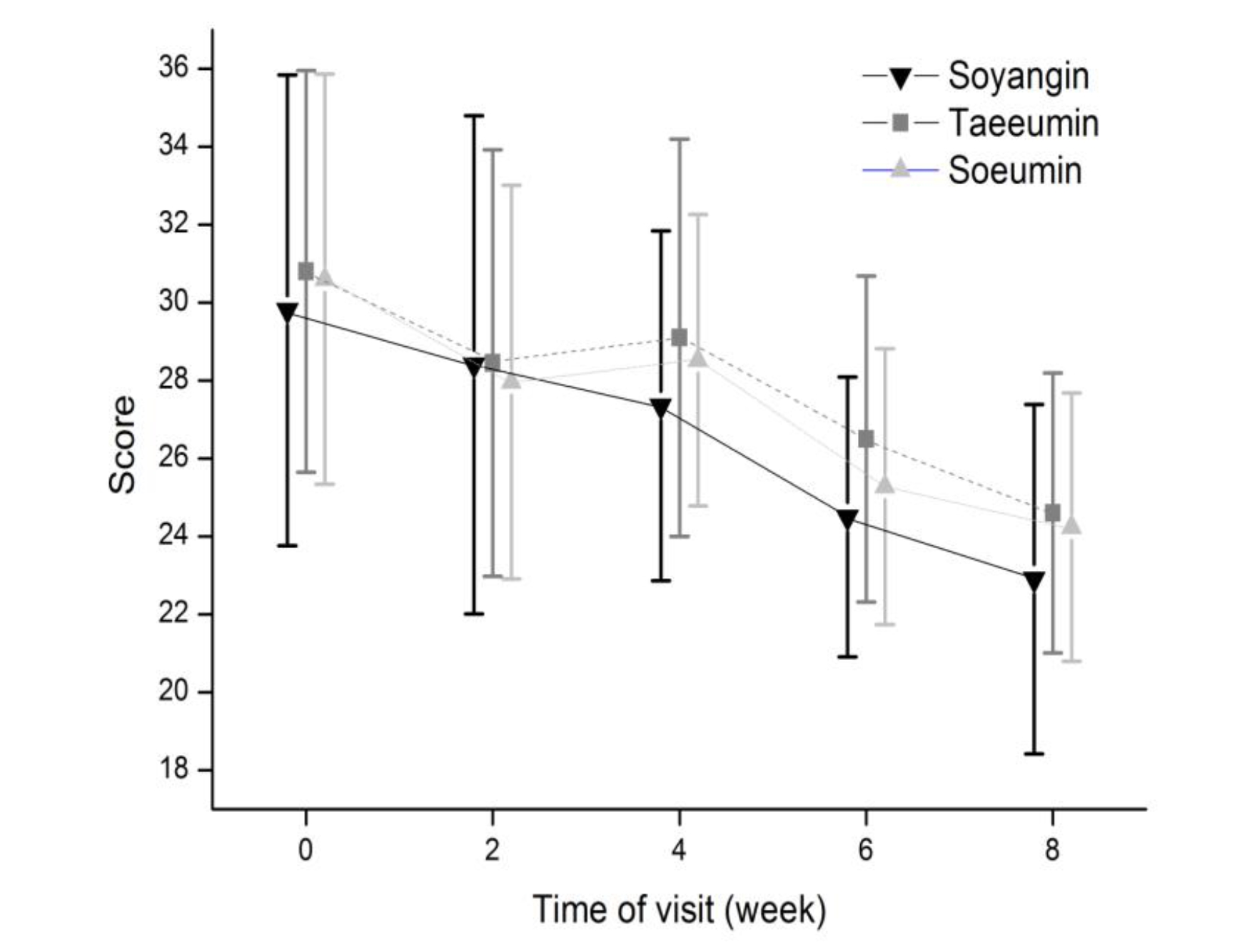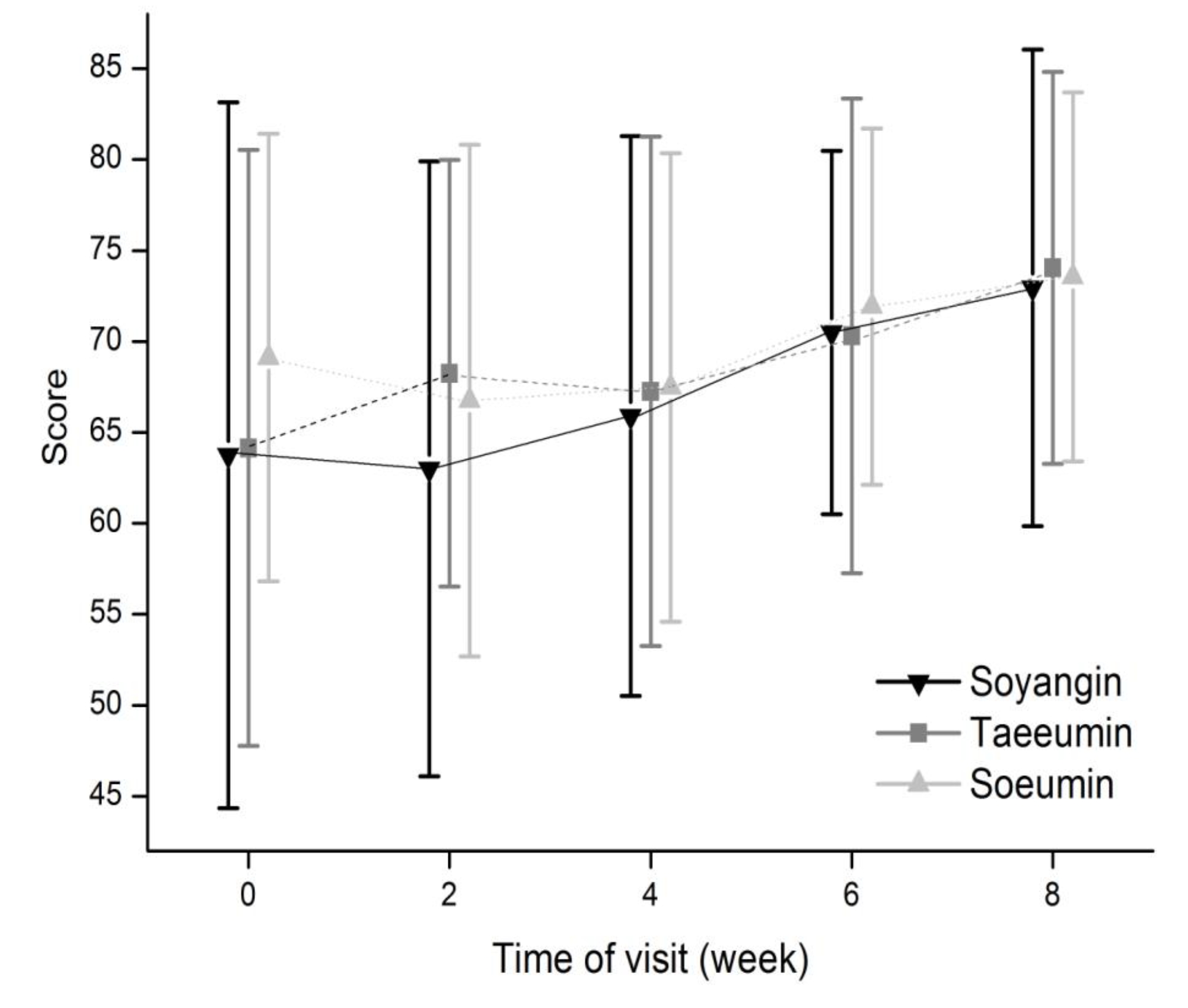



In Korea, 27.6% of patients who visit local clinics complain of fatigue, and 11.4% of patients who visit local hospitals are affected in daily life by fatigue. The prevalence of chronic fatigue was reported as 8.4% in a local clinic. Generally, people aged between 40 and 59 are called middle aged adults. In America, the prevalence of chronic fatigue was 31.2% in middle aged adults [1, 2]. The treatment and management of fatigue require a systematic approach because the symptoms or the diseases related to fatigue have a tendency to be chronic. Especially, in Korean medicine, unified diagnostic criteria and tools, as well as medications, for the treatment and the management of fatigue need to be developed [3].
Generally, the results of clinical pathological and radiological tests on patients complaining of fatigue are normal even though they are suffering from it. Thus, various techniques, the visual analogue scale (VAS), the numeric rating scale (NRS), the fatigue severity scale (FSS) and the Chalder fatigue scale (CFS), are used for diagnosing fatigue [4-6]. In journal reports and magazine articles, herbal medicines, pharmacopunctures, acupuncture, moxibustion, and herbal teas are used to treat diseases and to manage symptoms, but systematic studies and surveys are lacking [7, 8]. In this study, subjects who complained of fatigue were classified by constitution, were treated by using constitutional herbal tea, and were assessed by using their CFS and VAS scores. The items analyzed in this study were the changes in the CFS and the VAS scores and in the blood test indices related to the safety of the tea.
Males and females aged between 40 and 59 years who had complained of fatigue for 1 month consistently or for 6 months intermittently without a definite cause were recruited. At the same time, a CFS score of 19 was essential for participation in this study. Exclusion criteria included diseases such as diabetes mellitus, depression, hypoglycemia, thyroid disorder, angina pectoris, renopathy, alcoholic liver injury, liver cirrhosis, rheumarthritis, cancer; medications like beta blockers, alpha blockers, anticholinergic drugs, antidepressants, antihistamines; treatment for fatigue within 1 month; occupational fatigue; physical defect with an appropriate diagnosis; pregnant or menopausal women; cognitive impairment; lack of consent to participate.
This study was approved by the institute review board of W hospital (W-IRB-2013-0002). The number of subjects initially enrolled was 118. Seventy eight subjects remained after screening. Of those 78, 5 subjects were excluded due to surgery, medication, age, and refusal to participate, and 8 subjects were excluded based on blood and medical device tests. Thus, 65 subjects completed the entire selection process and were included in the study (Fig 1).
The trail took eight weeks to complete. At the first assessment, screening, completion of the consent form, the blood tests, and the diagnosis of the Sasang constitution were accomplished, and the CFS and the VAS scores were obtained. At the second assessment, two weeks after the first assessment, the CFS and the VAS scores were checked by telephone. At the third assessment, four weeks after the first assessment, the CFS and the VAS scores were checked by telephone, and the constitutional herbal teas were prescribed. At the fourth assessment, six weeks after the first assessment, the CFS and the VAS scores were checked by telephone. At the fifth assessment, eight weeks after the first assessment, the CFS and the VAS scores were checked, and blood tests were done (Fig 2).
For the diagnosis of the Sasang constitution, the Sasang Constitutional Analysis Tool (SCAT) was used, and a specialist in Sasang constitutional medicine made final diagnosis based on the SCAT results [9].
The compositions of the constitutional herbal teas originated in the prescriptions of the Donguisusebowon (Longevity and Life Preservation in Oriental Medicine), which is a classic in Sasang constitutional medicine in Korea. The prescriptions in the Donguisusebowon number 130 : 10 sets in Taeyangin, 36 sets in Soyangin, 44 sets in Taeeumin, and 40 sets in Soeumin. The constitutional herbal tea of Taeyangin consists of Acanthopanax Root Bark (8 g) and Fruit of Bower Actinidia (8 g), that of Soyangin consists of Saposhnikoviae Radix (8 g) and Rehmaniae Radix Preparata (8 g), that of Taeeumin consists of Platycodi Radix (8 g) and Puerariae Radix (8 g), and that of Soeumin consists of Ginseng Radix Alba (8 g) and Cinnamon Bark (8 g). The subjects took the constitutional tea twice a day for one month.
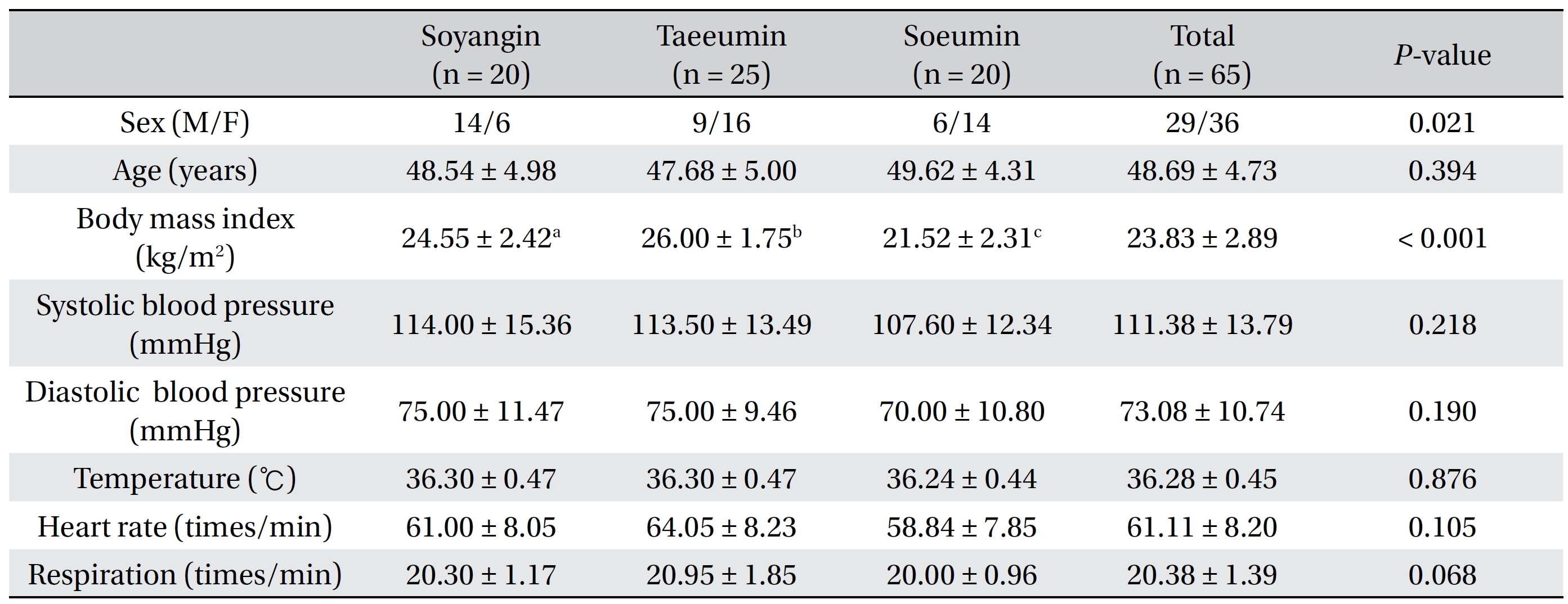
Comparison of the general characteristics of the subjects with chronic fatigue according to Sasang constitution
The first outcome measure for assessing the efficacy of the constitutional herbal tea was the CFS score (Fig 3), and the second outcome measure was the VAS score (Fig 4) Renal function and liver function tests were analyzed to ensure the safety of the constitutional teas. All data were analyzed by using the SPSS
All data were analyzed by using the SPSS program (version 20.0). The statistical significance was determined by using a cross-tabulation analysis, an analysis of variance with the Duncan post hoc test, and a repeated measure a one-way analysis of variance (ANOVA).
The sexual distribution of subjects was 29 males and 36 females, and the Sasang constitutional distribution was 20 Soyangin (14 males and 6 females), 25 Taeeumin (9 males and 16 females), and 20 Soeumin (6 males and 14 females) (
No significant differences in the CFS and the VAS scores or in the blood urea nitrogen (BUN), creatinine, aspartate aminotransferase (AST), alanine aminotransferase (ALT), and alkaline phosphatase (ALP) levels were observed (Table 2). In Soyangin, the values of the CFS score from week 0 to week 8 were 29.80 ± 6.04, 28.40 ± 6.39, 27.35 ± 4.49, 24.50 ± 3.59, and 22.90 ± 4.48. In Taeeumin, those values of the CFS score were 30.80 ± 5.16, 28.45 ± 5.47, 29.10 ± 5.10, 26.50 ± 4.19, and 24.60 ± 3.59, while in Soeumin, they were 30.60 ± 5.27, 27.96 ± 5.05, 28.52 ± 3.74, 25.28 ± 3.54, and 24.24 ± 3.44. The differences within each constitution were significant (

Comparison of the examination results in subjects with chronic fatigue according to Sasang constitution
In Soyangin, the values of the VAS score from week 0 to week 8 were 63.75 ± 19.39, 63.00 ± 16.89, 65.90 ± 15.39, 70.50 ± 9.99, and 72.95 ± 13.09; in Taeeumin, they were 64.15 ± 16.39, 68.25 ± 11.73, 67.25 ± 14.00, 70.30 ± 13.05, and 74.05 ± 10.78, while in Soeumin, they were 69.12 ± 12.31, 66.76 ± 14.07, 67.48 ± 12.88, 71.92 ± 9.79, and 73.56 ± 10.14. The differences within each constitution were significant (
At the first assessment visit (week 0), the average levels of AST were 23.51 ± 5.38 IU/L for all subjects, 25.15 ± 5.59 IU/L for Soyangin, 23.55 ± 5.38 IU/L for Taeeumin, and 22.16 ± 5.03 IU/L for Soeumin. At the fifth assessment visit (week 8), the average values were 22.92 ± 5.39 IU/L for all subjects, 22.30 ± 6.26 IU/L for Soyangin, 21.30 ± 4.33 IU/L for Taeeumin, and 24.72 ± 5.06 IU/L for Soeumin. The levels of AST for all subjects and for Soyangin and Taeeumin subjects while the level of AST for Soeumin subjects increased. The differences within each constitution were significant (
[Table. 3] Changes in blood tests to evaluate safety according to Sasang constitution

Changes in blood tests to evaluate safety according to Sasang constitution
Those with a Soyangin constitution from among the Sasang constitutions and those with liver-kidney Yin-deficiency pattern complain of chronic fatigue more than those of any other Sasang constitution or those with any other syndrome differentiation pattern [10]. Taeeumin has the largest proportion in the general Sasang constitutional distribution, but based on this study, Taeeumin has a decreasing tendency for complaining of chronic fatigue, which means that Soyangin and Soeumin are vulnerable to attacks of chronic fatigue.
In Korean medicine, in spite of the symptoms or the diseases being the same, different herbal drugs, prescriptions, acupuncture procedures, and pharmacopunctures are used. The same therapeutics can lead to different results of treatment [11-14]. Thus, the herbal tea should be composed differently for each constitution. A herbal tea is a therapeutic located between a tea and a drug and can be taken easily in daily life. Constitutional herbal teas consist of two herbal drugs in each constitution. One of two drugs increases circulation to overcome Qi movement stagnation, and the other strengthens weak viscera and bowels. Acanthopanax Root Bark, which is the Taeyangin drug, Saposhnikoviae Radix, which is the Soyangin drug, Platycodi Radix, which is the Taeeumin drug, and Ginseng Radix Alba, which is the Soeumin drug, circulate the Qi of each constitution. Fruit of Bower Actinidia, which is the Taeyangin drug, Rehmaniae Radix Preparata, which is the Soyangin drug, Puerariae Radix, which is the Taeeumin drug, and Cinnamon Bark, which is the Soeumin drug, strengthen the weak viscera and bowels of each constitution. A few studies address treating fatigue by using Acanthopanax Root Bark and Ginseng Radix Alba, but none address the other six drugs [15, 16]. Thus, studies on the composition of each constitutional herbal tea, experimental research on each drug, and efficacy assessments based on clinical trials with control and experimental groups are necessary.
The CFS score at the first assessment was 30.42 ± 5.41, which is a very high score compared to the values of 14.2 ± 4.6 for people without fatigue and 24.4 ± 5.8 for Americans with chronic fatigue [17]. This clearly indicates that the subjects in this study were experiencing extreme fatigue at the first assessment, but the CFS score was decrease by an amount from 6.36 to 6.90 in each constitution after 8 weeks. The VAS score of health status was increased by 9.90 in Taeeumin and by 4.44 in Soeumin. These desirable results arise from the indirect health management gained by participating in the study and taking the constitutional herbal tea for one month. The indirect health management gained by participating in the study is regarded as counseling, which is usually more effective for treating depression and insomnia [18-20].
Constitutional herbal tea may be used to reduce fatigue and improve health state and has no adverse effect on either the kidneys or the liver.
